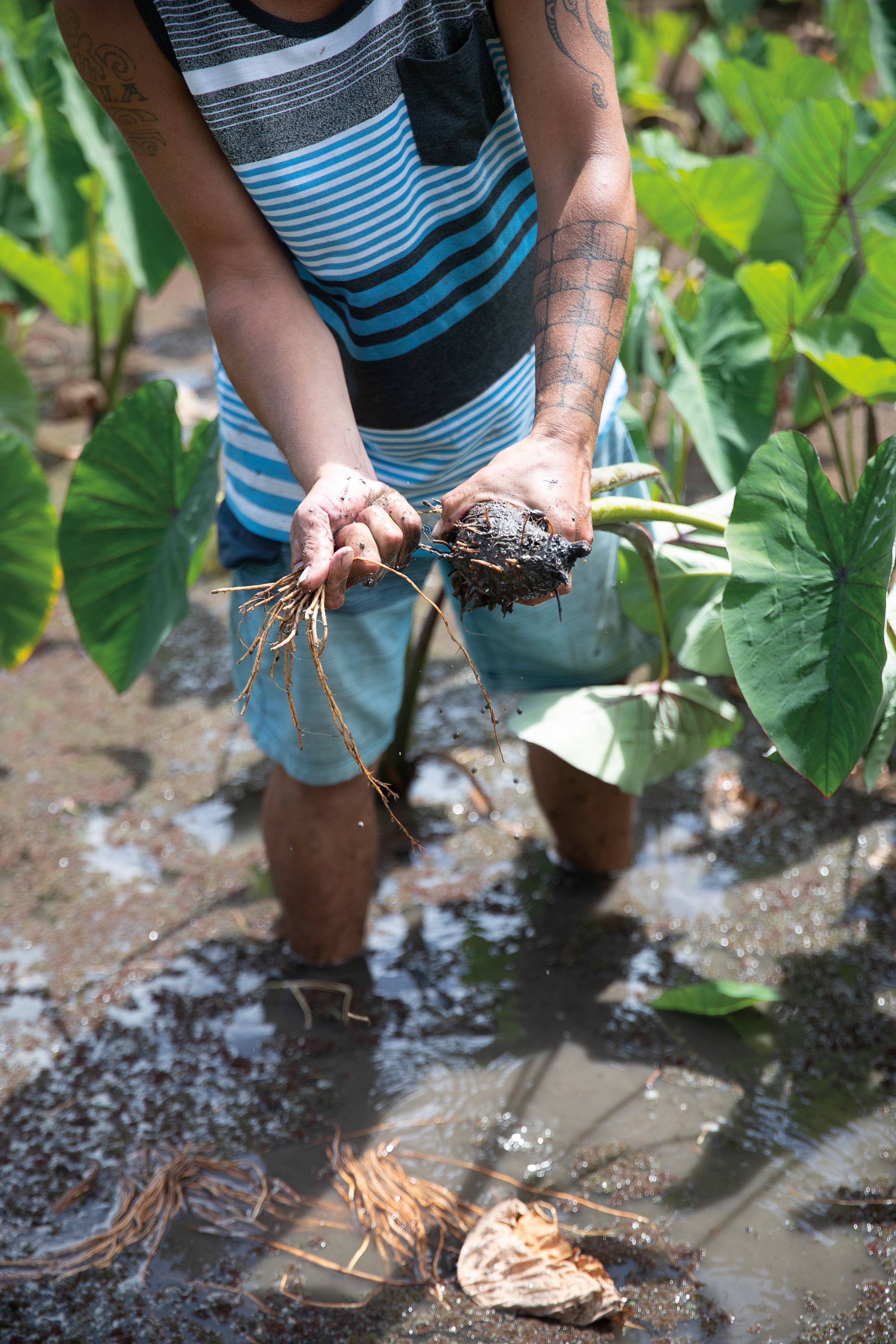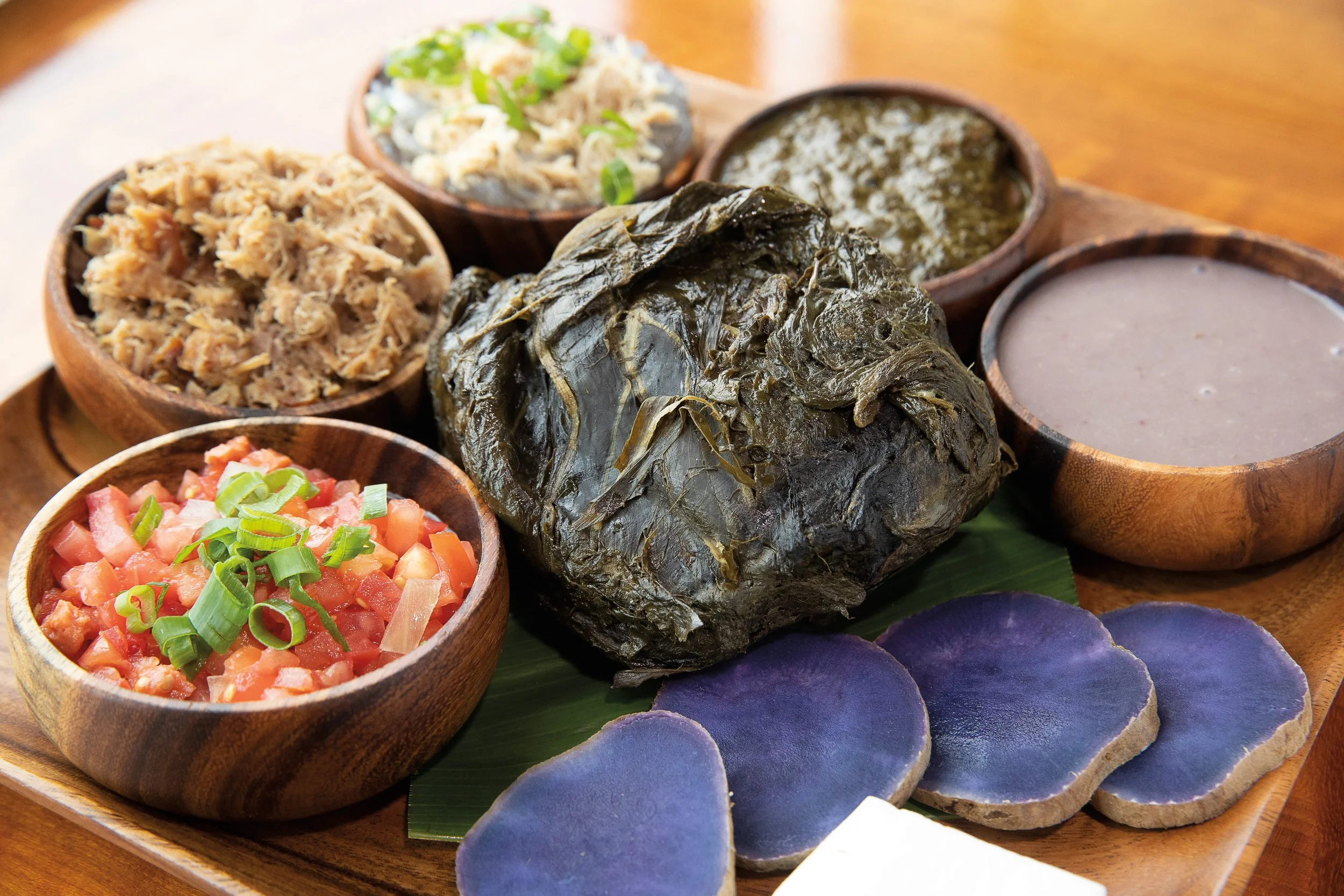Taro! Taro! Taro!







As my feet slipped beneath the brackish water, I asked taro farmer Kacy Kikila if anything lurked beneath. “Sharks,” he chuckled as large, leafy taro leaves swayed around him in the lo‘i patch his family had farmed for decades on O‘ahu’s Windward side. As I stood thigh high in the flooded field, Kikila instructed me how to reach deep into the water and grab the stem and pull it up from the squishy mud. Reaching deep into the water, I grasped the stem of the taro, or kalo as it is locally known, and I pulled the root from its muddy depths into the sunlight. No bigger than a large papaya and covered with a thick bark, taro serves as an important crop for Native Hawaiians and Polynesians across the Pacific.
Mud Hen Water chef du cuisine Alika Chung (who is part Hawaiian) provides me with a little more insight: “Without taro, Hawaiians would not have been able to make the journey in their canoes to get here,” he says. “[Taro] is highly nutritious, will not go bad, and it sustained the explorers [on their journey].”
Several dishes at Mud Hen Water reflect the cultural heritage of Chung with a few contemporary twists. When asked by local farmers to use the bi-product of cooked taro, restaurateur Ed Kenney and Chung created a koena hummus dish, a local take on the Mediterranean favorite, garnished with local veggies, feta cheese and inamona dukkah — a local take on a Middle Eastern spice. According to Kenney, “We found the outside scraping of steamed taro was not good for making poi, but it was starchy and good for making hummus.” This allows them to make use of the entire plant.
The restaurant also created a Moloka‘i Venison Lau Lau served with a sour poi vinaigrette which helps cut through the richness of the game. Chung says they mix Hawaiian chili pepper water with a continuously fermenting poi batch they keep in their kitchen to create their uniquely sour condiment.
While Mud Hen Water experiments with the beloved canoe plant, longtime Hawaiian eatery Highway Inn sticks to the staple prepared the classic way. Highway Inn has kept their menu unchanged since the restaurant was established in 1947. “What we do best with our menu is stay traditional,” says Monica Toguchi Ryan, third generation owner of Highway Inn, with locations at SALT at Our Kaka‘ako and Waipahu. “We’ve had guests crying after eating at our restaurants because our food reminded them of growing up on the plantation,” she says.
A year after he and his family were released from a Japanese internment camp on the mainland, Highway Inn founder Seiichi Toguchi opened his landmark restaurant in Central O‘ahu. In his teens, Toguchi started as a dishwasher in local restaurants where he learned to cook Hawaiian food and learned the value of culture and heritage through food. While Highway Inn offers local comfort and contemporary dishes, “We still identify with our Hawaiian food menu,” Toguchi Ryan says. All our taro is sourced locally and “we do our best to use every part of the plant for our Hawaiian dishes.” They use the lu‘au leaves for their lau lau and their squid luau and the root to make poi. “Many of our core Hawaiian food items have largely remained unchanged,” Toguchi Ryan notes as she says the restaurant regularly sees multigenerational families continue to eat at the humble restaurant her grandfather opened more than 70 years ago.
Thankfully, taro has also found its way into a myriad other delicious goods outside the restaurant realm. Several local companies have turned the root into a variety of products. At Hawaiian Chip Company, dry land taro is turned into gourmet chips. Along with Okinawan sweet potatoes, the locally sourced taro is peeled by hand and cooked until crispy. Liliha Bakery’s famous poi mochi donuts are made by blending local poi and mochi to create their stellar Japanese/Hawaiian treat. SomiSomi, a Korean-inspired dessert shop in Ala Moana Center sells fish-shaped waffles filled with a sweet taro ice cream. Adela’s Country Eatery on O‘ahu’s Windward side offers house-made pastas that include purple taro noodles made from local taro flour.
Back at Waihe‘e Wai Farms, Kikila shares that he never expected to see his family’s lo‘i patch flourish once more. For a long time, Kikila saw the family taro fields go unused due to the backbreaking farmwork it entailed. But five years ago, schoolteacher Van Velasco took a group of his students to help clear some of Kikila’s taro patch when he and Kikila decided to grow taro as a business and success steadily followed. Today, Waihe‘e Wai Farms grows thousands of pounds of taro each season, and Kikila and Velasco hope that a new generation will continue to keep their now shared legacy alive in the years to come.
